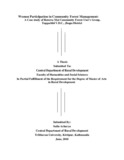Please use this identifier to cite or link to this item:
https://elibrary.tucl.edu.np/handle/123456789/3665Full metadata record
| DC Field | Value | Language |
|---|---|---|
| dc.contributor.author | Acharya, Sailu | - |
| dc.date.accessioned | 2021-07-29T10:25:50Z | - |
| dc.date.available | 2021-07-29T10:25:50Z | - |
| dc.date.issued | 2010 | - |
| dc.identifier.uri | http://elibrary.tucl.edu.np/handle/123456789/3665 | - |
| dc.description.abstract | Nepal is one of the least developed countries in the world. It is characterized by itsmountainous terrain which makes basic infrastructure and communicationdevelopment difficult. The people of Nepal are heavily reliant on subsistenceagriculture, most of which is historically focused on the Terai area of Nepal.Forests are an integral part of the agriculture and lives of people in these area.They provide timber for housing, fuel wood, fodder for stock and leaf litter forcomposting among many other things. Nepal used to be very rich in terms of forestresources and biodiversity. It is the main source of firewood, timber, litters andanimal fodder. A vast majority of the population in rural Nepal is directly involvedin managing forest as part of their everyday life. At the beginning whenthe size of population was small as compared to the vastarea of forest, exploitation of forest resources by the people had less adverse effecton environment and the socio-economy. The rapid growth in population resultedmultifarious impact. The rapid socio-economic changes in Nepal have placed anew demand on forest resources. People are cutting trees for expanding theiragricultural land. So Nepal's forests are gradually disappearing causing a majorecological crisis. In the present context, it is the most focused and prioritized program of theforestry sector to promote the forest situation in the country. Community forestryis an approach to forest management intended primarily to benefit the local usersof forests. The main objectives of the community forestry program is to involveand participate community members in the conservation and management ofnatural resources in a sustainable manner in-order to fulfill the dailyrequirements of fodder, forages, bedding materials for animals, firewood and timber. The community forestry program is aimed at community development andparticularly at meeting the household needs. Women’s participation is the most important aspects and activities of communityforest management in Nepal. Since they are the key stakeholders with the forestresources, definitely they have vital role as well as idea to use it in sustainablemanner. When a rural woman became the member of FUG Committee then hernew developmental role will be started. Groups meet to discuss communityforestry rights and responsibilities. Women’s participation also depends upon howmany villagers understood the rights and authority of the FUG Committeemembers. The frequencies of meeting, assembly and people’s participation alsoaffect the women’s participation. In Nepalese context, the level of supports given to the women by male counterpartdetermines the participation of women in any outdoor activities in the community.Traditional norms, powers in decision making roles and benefit sharing alsoaffected their participation. Thus, the greater the support from family, greaterwould be the chances of active participation of women in CF management. Also,educational status of people plays a key role for better involvement of women.There are other social factorsas well in our community that helps or hinders theactive participation of women in the CF activities. Basically, this study has beenconcentrated on the role of women in CF management as well as what are themajor factors that are either supportive or not supportive to women fromparticipating in the public sphere breaking the traditional boundary and theirrole. | en_US |
| dc.language.iso | en_US | en_US |
| dc.publisher | Department of Rural Development | en_US |
| dc.subject | Forest Management | en_US |
| dc.subject | Community Forestry | en_US |
| dc.title | Women Participation in Community Forest Management: A Case study of Ratuwa Mai Community Forest User's Group,Topgachhi V.D.C.,Jhapa District | en_US |
| dc.type | Thesis | en_US |
| local.institute.title | Central Department of Rural Development | en_US |
| local.academic.level | Masters | en_US |
| Appears in Collections: | Rural Development | |
Files in This Item:
| File | Description | Size | Format | |
|---|---|---|---|---|
| COVER.pdf | 24.15 kB | Adobe PDF |  View/Open | |
| CHAPTER.pdf | 250.49 kB | Adobe PDF |  View/Open |
Items in DSpace are protected by copyright, with all rights reserved, unless otherwise indicated.
